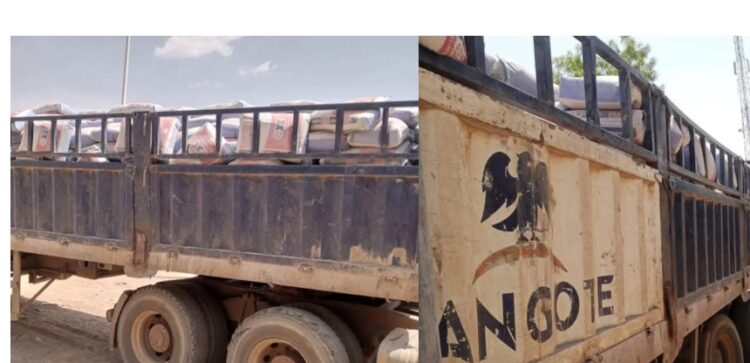How Dangote Cement made revenue of N2.07 trillion in 6 months of 2025
Dangote Cement Plc posted a stunning N2.07 trillion in revenue in just six months of 2025, reaffirming its dominance as Africa’s largest cement producer.
With half-year revenue already surpassing 57.86% of 2024’s full-year turnover, the company is on track for another record-breaking performance despite volume declines and rising costs.
Dangote Cement Plc is Africa’s biggest cement producer. The company manufactures and sells cement, the essential raw material for building houses, bridges, and roads. Its main plants are in Obajana (Kogi State), Gboko (Benue State), and Ibese (Ogun State).
Through these factories, Dangote Cement supplies Nigeria and other African countries with millions of tonnes of cement every year.
This milestone cements its leadership in Nigeria’s manufacturing sector, highlighting its resilience in a tough operating environment.
Profits nearly tripled year-on-year, supported by strong pricing power and disciplined cost management. Dangote Cement closed H1 2025 with a healthy net profit margin of 25.12%, compared to just 10.79% in the prior year.
Business divisions
Dangote Cement keeps things simple. Its operations are divided into two broad areas:
Nigeria Operations – its largest arm, handling production, sales, and distribution across the country.
Pan-Africa Operations – plants and sales subsidiaries in over 9 African countries, exporting Nigerian cement where needed.
This structure helps the company reduce risk by balancing revenue from its home base with income from other fast-growing African markets.
What they sell to make money
The company’s core product is cement, sold in 50kg bags, jumbo bags, or bulk quantities for large projects.
Dangote makes money by producing cement at scale, then selling it to retail distributors, wholesalers, and large construction firms. Cement is a necessity in every construction site, from housing estates to federal highways, which guarantees consistent demand.
Revenue growth drivers despite lower volumes
The company’s revenue grew by 17.70% year-on-year, reaching N2.07 trillion in H1 2025, up from N1.76 trillion in H1 2024. Remarkably, this half-year revenue already accounts for 57.86% of its full-year 2024 revenue (N3.58 trillion), underscoring the strength of its topline performance.
Interestingly, this revenue surge came despite a 4.08% decline in sales volume from 13.93 million tonnes in H1 2024 to 13.37 million tonnes in H1 2025. This suggests that price adjustments and strategic regional demand outweighed volume declines.
This reflects effective pricing strategies and resilient demand across key markets, despite pressure on sales volumes. With H1 2025 revenue already accounting for 54% of FY 2024 turnover, the company is well-positioned to outperform last year’s sales, underscoring its strength in core markets.
The inventory turnover ratio of 1.23x shows that the company sold its stock more than once in six months, translating to about 2.5 times annually a healthy rate for the cement industry. Likewise, a receivables turnover of 14.61x demonstrates Dangote’s strong market leverage and ability to secure quicker customer payments.
Revenue by segment and geographical contribution
Cement and clinker sales remained the company’s lifeblood, contributing 99.99% of total revenue. Other products brought in just N12 million, about 0.001% of overall sales, highlighting the company’s core dependence on cement.
Clinker is an intermediate product in cement production made by heating limestone and other raw materials in kilns at very high temperatures, whereas cement is the final product, made by grinding clinker with gypsum and other additives.
Dangote often exports clinker to other countries or sells it to third parties who grind it into cement. However, there is no separate breakdown for each of these products in the revenue segment.
Breaking down the revenue by geographical dominance, Nigeria accounted for 67.89% (N1.44 trillion) compared to 55.12% (N991.38 billion) in H1 2024, while Pan-African operations contributed 32.11% (N682.12 billion), a decline from the 44.88% (N807.11 billion). The balance was adjusted for eliminations, reinforcing the company’s dual-market strategy: dominance at home, steady growth abroad.
Nigeria contributed the most to the company’s revenue at 67.89% while other African countries altogether contributed 32.11% to the top line (revenue).
The Pan-Africa countries include – South Africa, Ethiopia, Ghana, Kenya, Zambia, Senegal, Cameroun, Tanzania, Sierra Leone, Liberia, Guinea, D.R. Congo, Cote D’Ivoire, Togo, Zimbabwe, Gabon, Burkina Faso, Chad, Mali, Niger, Madagascar, Benin, Mozambique.
Profit margin pressures eased
Operating profit climbed 47.0% year-on-year to N810.98 billion in H1 2025, up from N551.60 billion in the same period of 2024, while operating margin improved slightly to 39.19% from 31.34%. Pre-tax profit surged 149.2% YoY to N730.03 billion, almost two and a half times the prior year.
The earnings boost was driven by a 17% revenue increase alongside a more efficient cost profile. Cost of sales declined to 41.20% of revenue (N853.56 billion), compared to 47.34% in H1 2024, meaning the company spent less relative to the revenue growth achieved. As a result, gross profit rose to N1.22 trillion, representing a margin of 58.8% and already accounting for 62.95% of full-year 2024 levels.
Profitability was further strengthened by a lower net finance expense. Finance costs dropped to N216.16 billion from N332.52 billion a year earlier, while finance income more than quadrupled to N113.26 billion from N24.79 billion. This resulted in net finance expenses of just N102.91 billion, compared to N307.72 billion in H1 2024. Overall, net income margin expanded sharply to 25.12%, from 10.79% last year, underscoring the company’s improved profitability profile.
Liquidity concerns
Trade and other receivables surged 43.03% to N166.98 billion, indicating a significant rise in payments yet to be converted into cash.
Inventory rose 6.96% to N716.29 billion, reflecting a buildup of stock to support sales.
Cash and cash equivalents fell 14.66% to N383.90 billion, reducing immediate liquidity buffers.
Who else is in the game
In Nigeria, Dangote Cement competes directly with BUA Cement and Lafarge Africa. BUA Cement is its closest challenger locally, but Dangote still commands the biggest share of Nigeria’s cement market.
Globally, it faces pressure from multinational giants like LafargeHolcim and HeidelbergCement.
What makes Dangote Cement stand out is its scale is as it produces more than its rivals combined in Nigeria and has extended operations to countries like Ethiopia, Senegal, and Tanzania.
What this tells us
Here’s what it all boils down to: Dangote Cement is Africa’s cement powerhouse. It dominates Nigeria’s market, enjoys healthy profit margins, and continues to expand across the continent. Rising costs remain a challenge, but its pricing power has shielded it so far.
For investors and observers, the company’s ability to turn 2 trillion naira in 6 months into N730 billion profit highlights just how strong its business model is.
Dangote Cement makes its money from the cement in nearly every Nigerian building project you see, and it does so more profitably than almost any other manufacturing company in Africa.
Follow us for Breaking News and Market Intelligence



